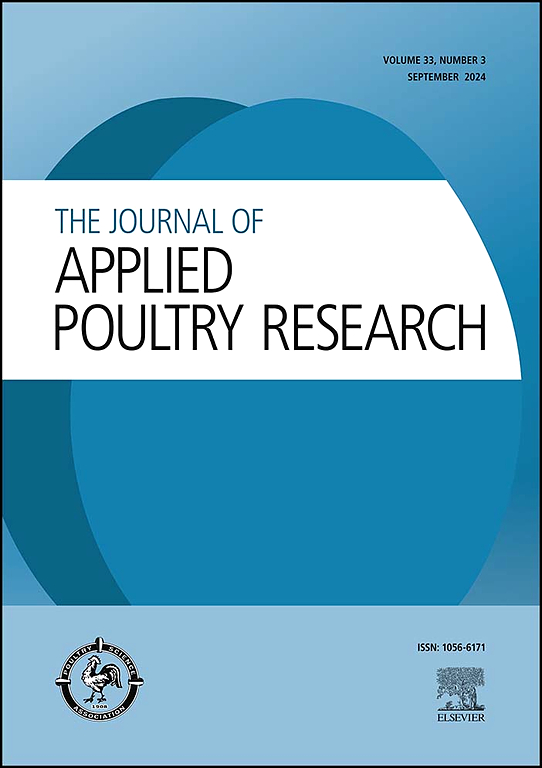Performance and carcass characteristics of Barred Plymouth Rock chickens in comparison to broilers
IF 2
3区 农林科学
Q2 AGRICULTURE, DAIRY & ANIMAL SCIENCE
引用次数: 0
Abstract
The popularity of keeping small flocks of chickens has brought with it an interest in the production characteristics of heritage breeds of chicken. The definition of heritage chicken breed is one that physically conforms to the standards of the American Poultry Association; mates naturally; has a long, productive outdoor lifespan; and a slow growth rate. Production information on raising meat Barred Plymouth Rocks is lacking since research focuses have been on diet formulation and genetics for broiler production. This study was undertaken to determine the production efficiency of Barred Plymouth Rocks as compared to broilers in body weight, feed intake, FCR, mortality, footpad lesion scores, carcass dressing percentage, skin color, parts, organ weights, and both bone length and width.
There were significant differences in body weight between broilers and Barred Plymouth Rocks throughout the study. Barred Plymouth Rocks took 17 weeks to reach a live body weight that was 17.35 % smaller than that of the broilers at six weeks. The Barred Plymouth Rocks required more than twice as much feed to reach nearly the same body weight as that of the broiler. There was a significant difference between the two breeds with regard to FCR; the broilers being the more efficient breed. The Barred Plymouth Rock had a significantly lower carcass dressing percentage of just under 65 % as compared to just over 68 % in broilers. The Barred Plymouth Rocks were less efficient at developing muscle on the carcass and more efficient at building bones and internal organs, had lower mortality, yellower skin on the breast area, and lower footpad lesions scores. This information will aid producers of niche market heritage chickens in their decision-making when considering this breed for meat production.
普利茅斯斑岩鸡与肉鸡的生产性能和胴体特性比较
饲养小群鸡的流行使人们对传统鸡品种的生产特点产生了兴趣。传统鸡的定义是符合美国家禽协会标准的鸡;自然交配的;具有较长的户外使用寿命;而且增长速度缓慢。由于研究的重点一直放在肉鸡生产的日粮配方和遗传学上,因此缺乏关于饲养肉鸡的生产信息。本试验旨在确定条纹普利茅斯岩鸡在体重、采食量、饲料比、死亡率、脚垫损伤评分、胴体屠宰率、皮肤颜色、部位、器官重量以及骨长和骨宽方面与肉鸡的生产效率。在整个研究过程中,肉仔鸡和棒状普利茅斯岩鸡的体重存在显著差异。条块普利茅斯岩鸡在17周内达到活重,比6周时的肉仔鸡小17.35%。为了达到与肉鸡几乎相同的体重,棒状普利茅斯岩鸡需要的饲料是肉鸡的两倍多。两个品种间FCR有显著差异;肉鸡是效率更高的品种。条纹普利茅斯岩肉鸡的胴体屠宰率低于65%,而肉鸡的胴体屠宰率略高于68%。条纹普利茅斯岩石在胴体上发育肌肉的效率较低,而在骨骼和内脏的形成方面效率较高,死亡率较低,乳房区域皮肤发黄,脚垫病变评分较低。这些信息将有助于利基市场传统鸡的生产者在考虑该品种用于肉类生产时做出决策。
本文章由计算机程序翻译,如有差异,请以英文原文为准。
求助全文
约1分钟内获得全文
求助全文
来源期刊

Journal of Applied Poultry Research
农林科学-奶制品与动物科学
CiteScore
4.10
自引率
10.50%
发文量
80
审稿时长
104 days
期刊介绍:
The Journal of Applied Poultry Research (JAPR) publishes original research reports, field reports, and reviews on breeding, hatching, health and disease, layer management, meat bird processing and products, meat bird management, microbiology, food safety, nutrition, environment, sanitation, welfare, and economics. As of January 2020, JAPR will become an Open Access journal with no subscription charges, meaning authors who publish here can make their research immediately, permanently, and freely accessible worldwide while retaining copyright to their work. Papers submitted for publication after October 1, 2019 will be published as Open Access papers.
The readers of JAPR are in education, extension, industry, and government, including research, teaching, administration, veterinary medicine, management, production, quality assurance, product development, and technical services. Nutritionists, breeder flock supervisors, production managers, microbiologists, laboratory personnel, food safety and sanitation managers, poultry processing managers, feed manufacturers, and egg producers use JAPR to keep up with current applied poultry research.
 求助内容:
求助内容: 应助结果提醒方式:
应助结果提醒方式:


